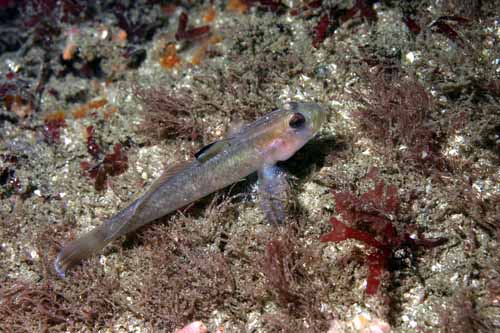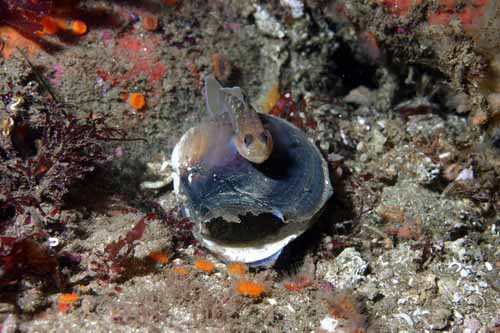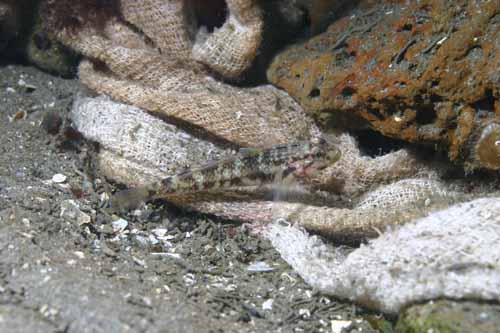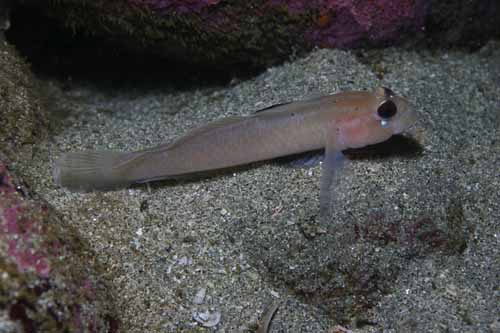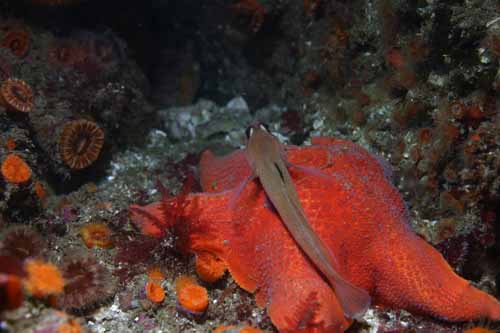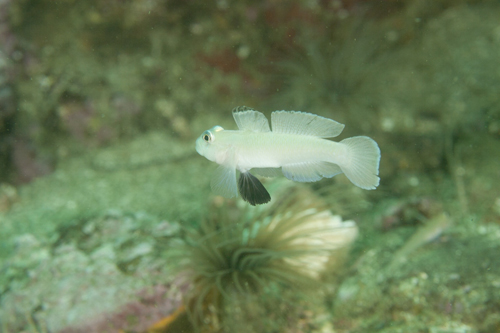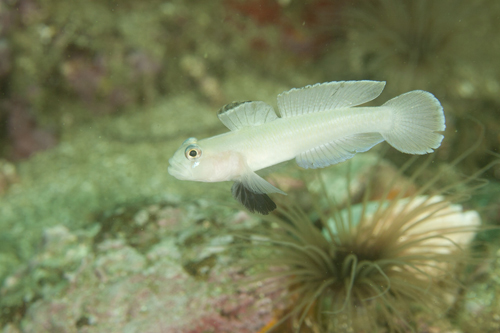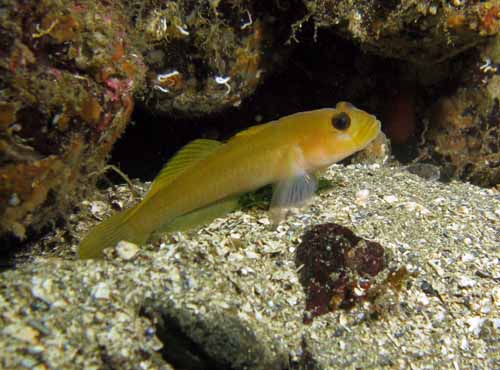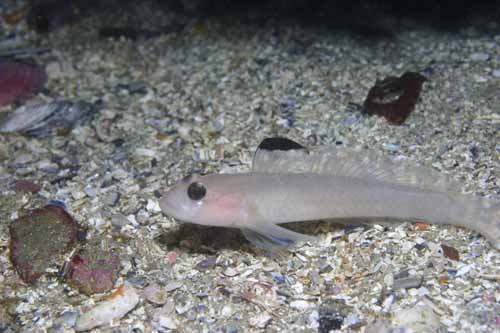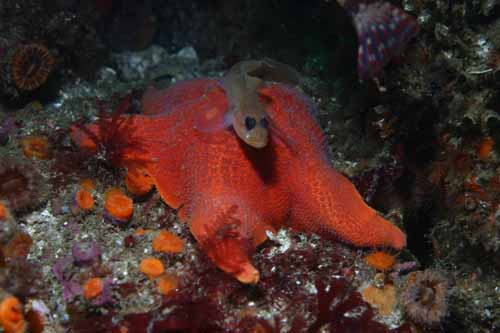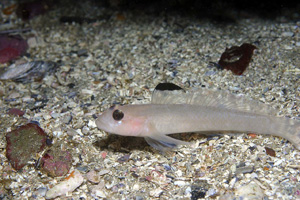
Blackeye goby
Rhinogobiops nicholsii
Overview
Key Features:
Pale white or light tan body, sometimes mottled, with large black eyes and a black edge on the distal portion of the anterior dorsal fin.Similar Species:
Northern Ronquil (Ronquilus jordani)Bay Goby (Lepidogobius lepidus)
Primary Common Name:
Blackeye gobySynonymous name(s):
Coryphopterus nicholsiiGeneral Grouping:
Bony fishesGeographic Range:
Wales Island, British Columbia, Canada to Punta Rompiente, Baja California Sur, Mexico
Rhinogobiops nicholsii occurs from the Wales Island, British Columbia, Canada to Punta Rompiente, Baja California Sur, Mexico.Intertidal Height:
0 to 0 feet (0 to 0 meters)Notes:
Rhinogobiops nicholsii is infrequent in the intertidal, though it can occur there.Subtidal Depth Range:
Minimum Depth: 0 meters or 0 feetMaximum Depth: 140 meters or 0 feet
Notes:
Rhinogobiops nicholsii is found in the subtidal down to 140 meters.Habitats:
bay (rocky shore), bay (sandy shore), exposed rocky shore, kelp forest, protected rocky shore, protected sandy beachesNotes:
Rhinogobiops nicholsii is found on sand, mud or rock bottoms near rocky outcrops and reefs from the intertidal to 140 meters. They are generally found in quiet and protected areas as they retreat to rocks or holes when approached. Rhinogobiops nicholsii may also occupy man-made litter, such as cans, jars and tires. They rest on the bottom near their home and blend in with the background. Young Rhinogobiops nicholsii are usually found offshore among plankton.Abundance:
Relative Abundance:
Rhinogobiops nicholsii is most common from 4 meters down to 140 meters.Species Description:
General:
Rhinogobiops nicholsii is in the family Gobiidae, shared by all Gobies. There are an estimated 2000 Goby species, at least 14 of which that are known from the coast of California.Distinctive Features:
Rhinogobiops nicholsii is elongate and almost round in cross section. Their coloring is usually very pale tan to olive with brown or greenish mottling and speckles. There is a distinct iridescent blue spot beneath each eye. They have long pelvic fins that reach the anus and their first dorsal fin has a black edge. The pelvic fins form a ventral sucking disc and they have two dorsal fins, of which, the second is long, almost reaching the rounded caudal fin. There is a fleshy ridge that extends from the area between the eyes to the dorsal fin. The scales of Rhinogobiops nicholsii are conspicuously large and cycloid. Their snout is round and their eyes are black. Breeding males can be distinguished by a black pelvic disk. The total number of dorsal spines is 5-7 and the number of dorsal soft rays is 12-14. There are no anal spines, but 11-12 anal soft rays.The Bay Goby, Lepidogobius lepidus, is similar to Rhinogobiops nicholsii, but can be distinguished by the lack of a black eye. The Northern Ronquil, Ronquilus jordani is also similar, but can be distinguished by its single dorsal fin.
Size:
The maximum size of Rhinogobiops nicholsii is 15 cm.Natural History:
General:
Like all Gobies, Rhinogobiops nicholsii, has pelvic fins that are usually united to form a disc or suction cup. They have two dorsal fins and while the anterior fin is composed of spines, the posterior fin is made up of soft rays, or occasionally one spine and the rest soft rays. The lateral line is not discernable in Gobies. Members of family Gobiidae are found in both tropical, temperate, and occasionally in freshwater. There are more tropical species than temperate.Rhinogobiops nicholsii is generally active during the day and takes shelter at night. These fish mature at about 2 years of age and live to about 5 years of age.
Predator(s):
Rockfish prey on Rhinogobiops nicholsii as well as Albacore, Thunnus alalunga. Pelagic, Phalacrocorax pelagicus, Brandt\\\\\\\\\\\\\\\\\\\\\\\\\\\\\\\'s, Phalacrocorax penicillatus and double-crested comorants, Phalacrocorax auritus also eat them.Prey:
Rhinogobiops nicholsii feeds on mollusks, such as limpets and snails and crustaceans, such copepods, amphipods and tiny shrimp.Feeding Behavior:
CarnivoreSeasonal Behavior
February - October
Reproduction:
Rhinogobiops nicholsii is oviparous with long spawning seasons between the months of February and October, but probably peaking in late spring and early summer. These fish may be multiple spawners.Once mature, the aggressive male claims a crevice, often by removing excess sand or silt. The male then lures a female into their cave through peculiar open mouth displays and by erecting his black pelvic fins and repeatedly rising off the bottom and settling back down. Once inside, the female will deposit about 3300 - 4800 minute pink eggs. The male guards the eggs for several weeks until they hatch and release tiny transparent larvae which reside temporarily at the ocean's surface.
Rhinogobiops nicholsii has been described as a protogynous hermaphrodite, which means the fish are born female and then change to males. For Rhinogobiops nicholsii this happens at a size of about 7 cm. Male Rhinogobiops nicholsii have also been found forming permanent harem groups composed several smaller females.
References
- Allsop, D.J. and S.A. West. 2003. Constant relative age and size at sex change for sequentially hermaphroditic fish. Journal of Evolutionary Biology 16:921-929.
- Boschung, H.T., J.D. Williams, D.W. Gotshall, D.K. Caldwell, and M.C. Caldwell. 1998. National Audubon Society Field Guide to North American Fishes, Whales and Dolphins. A.A. Knoph, New York, NY. 848 p.
- Cole, K.S. 1983. Protogynous hermaphroditism in a temperate zone territorial marine goby, Coryphopterus nicholsii. Copeia 1983:809-812.
- Eschmeyer, W.N., and E.S. Herald. 1983. A Field Guide to Pacific Coast Fishes of North America. Houghton Mifflin Company, Boston, MA. 336 p.
- Froese, R. and D. Pauly (eds.). 2006 (Updated 01/02/06). FishBase. World Wide Web electronic publication. http://www.fishbase.org, Accessed [04/25/06].
- Gotshall, D. 2001. Pacific Coast Inshore Fishes. Sea Challengers, Monterey, CA. 117 p.
- Humann, P. 1996. Coastal fish identification : California to Alaska. New World Publications, Jacksonville, FL. 205 p.
- Lamb, A. and P. Edgell. 1986. Coastal Fishes of the Pacific Northwest. Harbor Publishing, Madeira Park, BC, Canada. 224 p.
- Love, M. 1996. Probably more than you want to know about the fishes of the Pacific Coast. Really Big Press, Santa Barbara, CA. 381 p.
Related Information
Photo Library
Click on an image below to view a larger version in the SIMoN Photo Library. You will also be able to view important information on each photo such as photographer, date, caption and more
